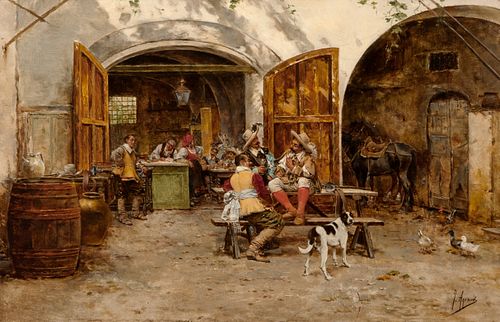JOAQUIN AGRASOT (Orihuela, Alicante, 1837 - Valencia, 1919). "Musketeers in an inn", 1885-1890. Oil on panel.
Lot 83
About Seller
Setdart Auction House
Carrer Aragó 346
Barcelona
Spain
Setdart Subastas was born in 2004 and is currently the first online art auction in Spain with solidity, prestige and reliability guaranteed by our more than 60,000 users. Setdart has a young, dynamic and enterprising team ready to successfully manage the purchase and sale of art works through custom...Read more
Estimate:
EUR€20,000 - EUR€30,000
$21,505.38 - $32,258.06
Absentee vs Live bid
Two ways to bid:
- Leave a max absentee bid and the platform will bid on your behalf up to your maximum bid during the live auction.
- Bid live during the auction and your bids will be submitted real-time to the auctioneer.
Bid Increments
| Price | Bid Increment |
|---|---|
| EUR€0 | EUR€10 |
| EUR€200 | EUR€25 |
| EUR€500 | EUR€50 |
| EUR€1,000 | EUR€100 |
| EUR€3,000 | EUR€200 |
| EUR€5,000 | EUR€500 |
| EUR€10,000 | EUR€1,000 |
| EUR€20,000 | EUR€2,000 |
| EUR€50,000 | EUR€5,000 |
About Auction
By Setdart Auction House
Nov 10, 2021
Set Reminder
2021-11-10 08:00:00
2021-11-10 08:00:00
America/New_York
Bidsquare
Bidsquare : 19th & 20th Century paintings and Decorative Arts
https://www.bidsquare.com/auctions/setdart-auction-house/19th-20th-century-paintings-and-decorative-arts-7800
Setdart Auction House sofia@setdart.com
Setdart Auction House sofia@setdart.com
- Lot Description
JOAQUIN AGRASOT (Orihuela, Alicante, 1837 - Valencia, 1919). "Musketeers in an inn", 1885-1890. Oil on panel. Signed in the lower right corner. Work reproduced in "JoaquÃn Agrasot y Juan (1836-1919). Anthological Exhibition", Alicante, Diputación Provincial, 2002, pp. 142-143. Measurements: 26.5 x 41 cm; 50 x 64.5 cm (frame). The portraits and scenes of musketeers were very popular among the Spanish bourgeois clientele of the 19th century, within a context still inherited from romanticism, which sought in the idealized recreation of the past an escape from everyday reality. Many painters of the time worked along these lines, seeking to capture scenes of the past with the greatest possible verism, recreated with precise attention to detail, worked with a language of academic roots or, as in the case of this panel, with a distinctly modern language, especially sensitive to light and atmosphere. This type of scenes starring musketeers are part of the genre of casacón painting, scenes worked with a special narrative and descriptive eagerness, which in Spain will have Velázquez and his contemporaries as the main formal reference. On this occasion Agrasot places a group of musketeers around a table in an interior courtyard, already recurrent in his production (his work "En el patio de una alquerÃa" shows his characters in this same location). In the background, inside the premises, a group in a relaxed chat with the innkeeper closes the composition in a masterful way. Agrasot was able to learn the genre of "tableautines" during his Roman stay, seeking to recall a historical France, recalled by the literature of the early nineteenth century, in whose genre the novelist Alexandre Dumas stood out. Agrasot began his training in his native Orihuela, where he was granted a pension from the Diputación de Alicante to study at the Escuela de Bellas Artes de San Carlos de Valencia. A disciple there of Francisco MartÃnez Yago, in his early years he won awards such as the gold medal at the Provincial Exhibition of Alicante in 1860. In 1863 he was granted a new pension, this time to travel to Rome, where he came into contact with Rosales, Casado del Alisal and Fortuny. With the latter he established close ties of friendship, and his painting was deeply influenced by the style of the Catalan painter. He periodically sent canvases to the National Exhibitions of Fine Arts, in which he obtained third medal in 1864 and second in 1867. Agrasot remained in Italy until 1875; after Fortuny's death he returned to Spain, already a painter of recognized prestige, was a member of the Academies of San Carlos and San Fernando, and participated as a juror in several artistic exhibitions. In 1886 he received the art medal at the Universal Exposition of Philadelphia, and in 1888 the second medal at the International Exposition of Barcelona. Agrasot's style is framed within realism, being especially interested in genre themes and regional costumbrismo. However, he also worked on nudes, oriental themes and portraits. He is represented in the Prado Museum, the Museum of Fine Arts in Valencia, the MUBAG in Gravina (Alicante) and the Academy of San Carlos in Valencia.
- Shipping Info
-
In-house shipping available. Please inquire at admin@setdart.com.
-
- Buyer's Premium



 EUR
EUR CAD
CAD AUD
AUD GBP
GBP MXN
MXN HKD
HKD CNY
CNY MYR
MYR SEK
SEK SGD
SGD CHF
CHF THB
THB
















